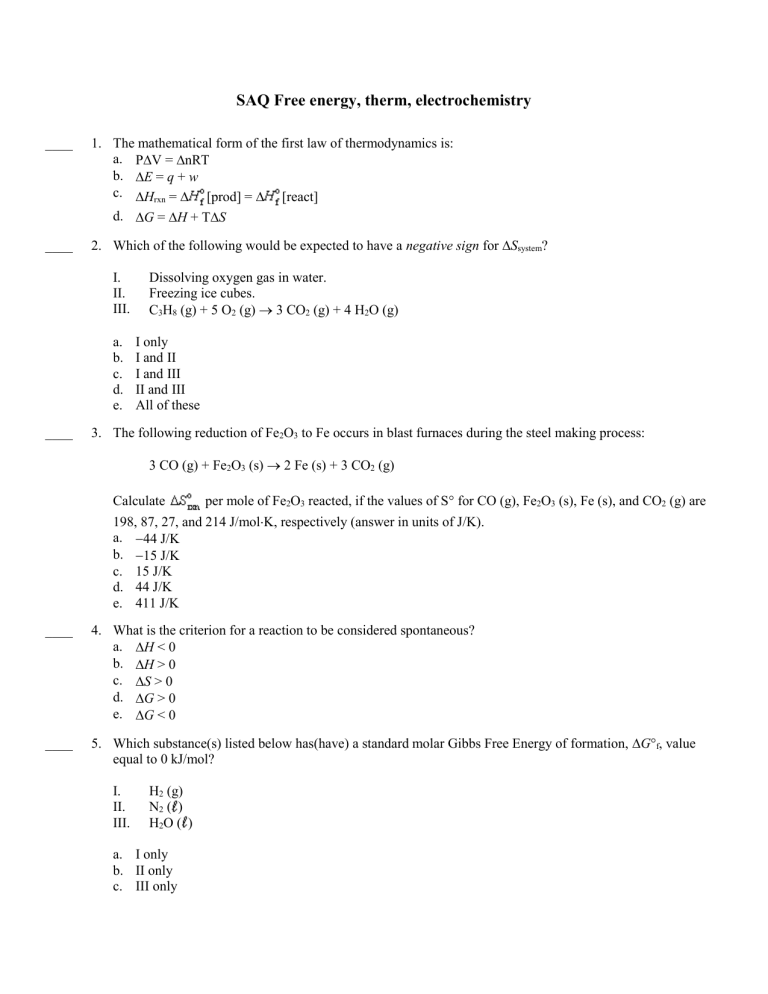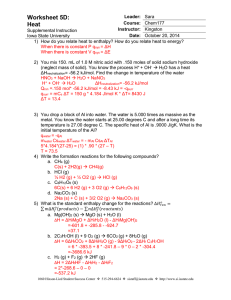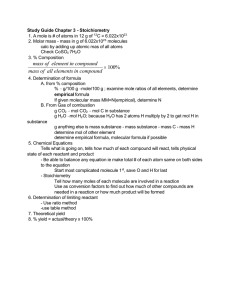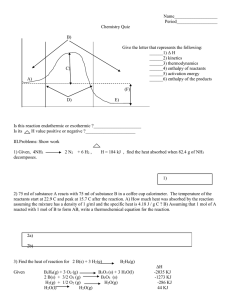
SAQ Free energy, therm, electrochemistry ____ 1. The mathematical form of the first law of thermodynamics is: a. PV = nRT b. E = q + w c. Hrxn = [prod] = [react] d. G = H + TS ____ 2. Which of the following would be expected to have a negative sign for Ssystem? I. II. III. a. b. c. d. e. ____ Dissolving oxygen gas in water. Freezing ice cubes. C3H8 (g) + 5 O2 (g) 3 CO2 (g) + 4 H2O (g) I only I and II I and III II and III All of these 3. The following reduction of Fe2O3 to Fe occurs in blast furnaces during the steel making process: 3 CO (g) + Fe2O3 (s) 2 Fe (s) + 3 CO2 (g) Calculate per mole of Fe2O3 reacted, if the values of S for CO (g), Fe2O3 (s), Fe (s), and CO2 (g) are 198, 87, 27, and 214 J/molK, respectively (answer in units of J/K). a. 44 J/K b. 15 J/K c. 15 J/K d. 44 J/K e. 411 J/K ____ 4. What is the criterion for a reaction to be considered spontaneous? a. H < 0 b. H > 0 c. S > 0 d. G > 0 e. G < 0 ____ 5. Which substance(s) listed below has(have) a standard molar Gibbs Free Energy of formation, Gf, value equal to 0 kJ/mol? I. II. III. H2 (g) N2 ( ) H2O ( ) a. I only b. II only c. III only d. I and II e. All of these ____ 6. The reaction PCl3 (g) + Cl2 (g) PCl5 (g) is exothermic. The reaction is: a. spontaneous at all temperatures. b. nonspontaneous at all temperatures. c. spontaneous at low temperatures. d. spontaneous at high temperatures. e. spontaneous if Grxn is positive. Exhibit 17-2 Consider the reaction below and its corresponding thermodynamic data to answer the following problem(s). 3 O2 (g) 2 O3 (g) H = 284.6 kJ/mol and S = 139.8 J/molK ____ 7. Refer to Exhibit 17-2. What is the Standard Gibbs Free Energy change, G, for this reaction at 25 C? a. G = 242.9 kJ/mol b. G = 281.1 kJ/mol c. G = 288.1 kJ/mol d. G = 326.3 kJ/mol e. G = 4.195 104 kJ/mol ____ 8. Refer to Exhibit 17-2. Which statement below is true regarding this reaction? a. This reaction is spontaneous at all temperatures. b. This reaction is spontaneous at relatively lower temperatures and non-spontaneous at higher temperatures. c. This reaction is spontaneous at relatively higher temperatures and non-spontaneous at lower temperatures. d. This reaction is non-spontaneous at all temperatures. e. There is not enough information to make an assessment. ____ 9. For 2 N2O (g) + O2 (g) 4 NO (g) at 298 K, H = +196 kJ, G = +140 kJ, S = +1.99 J/K. Which of the following changes would always increase the amount of NO at equilibrium? a. raise the temperature and lower the pressure b. raise the temperature and increase the pressure c. lower the temperature and lower the pressure d. lower the temperature and increase the pressure e. A decision is not possible from the information given. ____ 10. Calculate Kp for the reaction PCl5 (g) PCl3 (g) + Cl2 (g) at 25 C. The kJ/mol (PCl3), and 305 kJ/mol (PCl5). (R = 8.314 J/molK) a. 6.86 106 b. 3.24 1082 c. 3.27 107 d. 3.9 104 e. 3.08 1081 values are 0.0 (Cl2), 268 ____ 11. Consider a mixture of three gases at 25 °C in the following reaction and the reaction's corresponding Standard Molar Gibbs Free Energy: 2 HI (g) H2 (g) + I2 (g) G = 16.8 kJ/mol If the partial pressures of the three gases are PHI = 2.50 atm, PH2 = 3.5 atm and PI2 = 4.5 atm at 400 K, what is G under these non-standard conditions? a. G = 13.7 kJ/mol b. G = 17.4 kJ/mol c. G = 18.1 kJ/mol d. G = 19.0 kJ/mol e. G = 21.8 kJ/mol ____ 12. In the following balanced redox reaction: 14 HCl + K2Cr2O7 + 6 FeCl2 2 CrCl3 + 6 FeCl3 + 2 KCl + 7 H 2O a. b. c. d. e. K2Cr2O7 is oxidized. FeCl2 is a reducing agent. HCl is an oxidizing agent. HCl is oxidized. none of these. ____ 13. Which equation listed below is correct after balancing the following unbalanced equation under basic conditions? This content is now in 1211. I left it here in case you wanted to review. Shaw 3.19.20 MnO41 (aq) + Br1 (aq) MnO2 (s) + BrO31 (aq) a. b. c. d. e. [Basic conditions] MnO41 (aq) + Br1 (aq) + 2 OH (aq) MnO2 (s) + BrO31 (aq) + H2O MnO41 (aq) + 2 Br1 (aq) + 8 OH (aq) MnO2 (s) + 2 BrO31 (aq) + 4 H2O 2 MnO41 (aq) + Br1 (aq) + H2O 2 MnO2 (s) + BrO31 (aq) + 2 OH (aq) 2 H+ (aq) + 2 MnO41 (aq) + Br1 (aq) 2 MnO2 (s) + BrO31 (aq) + H2O 2 MnO41 (aq) + 2 Br1 (aq) + 4 OH (aq) 2 MnO2 (s) + 2 BrO31 (aq) + 2 H2O ____ 14. After balancing the following reaction under acidic conditions, how many mole equivalents of water are required and on which side of the reaction do they appear? This content is now in 1211. I left it here in case you wanted to review. Shaw 3.19.20 MnO41 (aq) + Cl1 (aq) Mn2+ (aq) + Cl2 (g) a. b. c. d. e. [Acidic conditions] 2 moles of H2O on the reactant side 2 moles of H2O on the product side 4 moles of H2O on the product side 8 moles of H2O on the product side 10 moles of H2O on the reactant side ____ 15. In a voltaic cell, the spontaneous reaction that occurs is Cr (s) + Cu2+ Cu (s) + Cr2+. Consider the following three statements and choose the correct answer. I. II. III. The chromium metal is the negative electrode. A salt bridge is unnecessary in this voltaic cell. Copper (II) ions are reduced. a. only I is true b. c. d. e. only III is true II and III are true, I is false I and III are true, II is false I, II, and III are all true Exhibit 18-2 Consider a voltaic cell that is constructed from a strip of Ag dipped in an AgNO3 solution and a Fe (s) strip dipped in a solution of FeCl2 to answer the following question(s). An external circuit and a salt bridge connect these two electrodes. Ag+1 (aq) + e Ag (s) E = 0.800 V Fe2+ (aq) + 2 e Fe (s) E = -0.44 V 3+ 2+ Fe (aq) + e Fe (aq) E = 0.771 V ____ 16. Refer to Exhibit 18-2. Which cell reaction ensues spontaneously in this voltaic cell? a. Fe2+ (aq) + 2 Ag (s) Fe (s) + 2 Ag+ (aq) b. Fe2+ (aq) + 2 Ag+ (aq) Fe (s) + 2 Ag (s) c. Fe (s) + 2 Ag (s) Fe2+ (aq) + 2 Ag+ (aq) d. Fe (s) + 2 Ag+ (aq) Fe2+ (aq) + 2 Ag (s) e. Fe2+ (aq) + Fe (s) 2 Ag1+ (aq) + 2 Ag (s) ____ 17. Refer to Exhibit 18-2. Which electrode is the negative electrode and what is the standard potential Ecell for this voltaic cell? a. The Fe2+/Fe couple is the negative electrode and Ecell = 1.24 V. b. The Fe2+/Fe couple is the negative electrode and Ecell = 0.36 V. c. The Fe2+/Fe couple is the negative electrode and Ecell = 1.24 V. d. The Ag+/Ag couple is the negative electrode and Ecell = 1.24 V. e. The Ag+/Ag couple is the negative electrode and Ecell = 0.36 V. ____ 18. Given: Ag+1 (aq) + e Ag (s) Cl2 (g) + 2 e 2 Cl (aq) Zn2+ (aq) + 2 e Zn (s) E = 0.800 V E = +1.36 V E = 0.76 V What is the proper arrangement for the order of increasing strength as a reducing agent? Ag (s), Cl (aq) and Zn (s) a. b. c. d. e. (weakest reducing agent) Ag (s) < Cl (aq) < Zn (s) (strongest reducing agent) (weakest reducing agent) Cl (aq) < Ag (s) < Zn (s) (strongest reducing agent) (weakest reducing agent) Zn (s) < Cl (aq) < Ag (s) (strongest reducing agent) (weakest reducing agent) Ag (s) < Zn (s) < Cl (aq) (strongest reducing agent) (weakest reducing agent) Cl (aq) < Zn (s) < Ag (s) (strongest reducing agent) ____ 19. Which of the following is associated with a redox reaction that would proceed spontaneously towards the product side of the equation without having any outside work supplied to the system? I. II. III. G < 0 Ecell > 0 Q/K < 1 a. b. c. d. e. I only II only III only I and II All of these ____ 20. Calculate Kc for the reaction Br2 + H2O H+ + Br + HOBr at 25 C given: HOBr + H+ + 2 e Br + H2O Br2 + 2 e 2 Br a. b. c. d. e. E = +1.33 V E = +1.07 V 1.6 109 2.5 104 6.1 108 1.2 1081 4.1 105 ____ 21. What is the value of Grxn in kJ/mol for the following unbalanced reaction? Mg (s) + Au3+ (aq) Mg2+ (aq) + Au (s) Ered(Mg2+/Mg) = 2.37 V and Ered(Au3+/Au) = 1.50 V a. b. c. d. e. Grxn = 2.24 106 Grxn = 1.85 106 Grxn = 7.47 105 Grxn = 1.85 103 Grxn = 2.24 103






